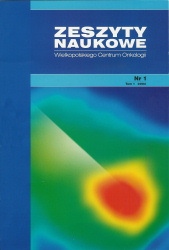Abstract
This study aimed to review and presentation of the way to manage the patient’s respiratory motion in radiotherapy. The review based on selected reports and research problems presented during ASTRO 59th Annual Meeting in San Diego.
References
Dieterich S. Respiratory Gating in Radiation Therapy. Educational section; Is There a “Best” Way to Manage Respiratory Motion? Materiały zjazdowe ASTRO 59th Annual Meeting, San Diego, CA, September 24 - 27, 2017.
Rahimi A. Using the breath hold technique in radiation treatments. Educational section; Is There a “Best” Way to Manage Respiratory Motion? Materiały zjazdowe ASTRO 59th Annual Meeting, San Diego, CA, September 24 - 27, 2017.
Descovich M. Hybrid tracking techniques with a robotic radiosurgery system Educational section; Is There a “Best” Way to Manage Respiratory Motion? Materiały zjazdowe ASTRO 59th Annual Meeting, San Diego, CA, September 24 - 27, 2017.
Sawant A. Dynamic MLC tracking. Educational section; Is There a “Best” Way to Manage Respiratory Motion? Materiały zjazdowe ASTRO 59th Annual Meeting, San Diego, CA, September 24 - 27, 2017.
Balter P, Caudell J, Dawson L, wsp. Challenging Cases in IGRT: Are We All Well Aligned?. Educational section; Is There a “Best” Way to Manage Respiratory Motion? Materiały zjazdowe ASTRO 59th Annual Meeting, San Diego, CA, September 24 - 27, 2017.
Simpson DR, Lawson JD, Nath SK, wsp. A survey of image-guided radiation therapy use in the United States. Cancer. 2010 15;116:3953-60.
Nabavizadeh N, Elliott DA, Chen Y, wsp. Image Guided Radiation Therapy (IGRT) Practice Patterns and IGRT's Impact on Workflow and Treatment Planning: Results From a National Survey of American Society for Radiation Oncology Members. Int J Radiat Oncol Biol Phys. 2016 15;94:850-7.
Li W, Jaffray DA, Wilson G, Moseley D. How long does it take? An analysis of volumetric image assessment time. Radiother Oncol. 2016;119:150-3.
Ju-Young S, Yong-Hyeob K, Jae-Uk J, wsp. Evaluation of Dose Distributions Recalculated with
Per-field Measurement Data under the Condition of Respiratory Motion during IMRT for Liver Cancer
Prog Med Phys. 2014;25:79-88.
Giraud P, Morvan E, Claude L, wsp. Respiratory gating techniques for optimization of lung cancer radiotherapy. Journal of Thoracic Oncology 2011;12:2058-68.
Saito T, Sakamoto T, Oya N. Comparison of gating around end-expiration and end-inspiration in radiotherapy for lung cancer. Radiother Oncol. 2009;93:430-5.
Cervino LI, Gupta S, Rose MA, wsp. Using surface imaging and visual coaching to improve the reproducibility and stability of deep-inspiration breath hold for left-breast-cancer radiotherapy.
Phys Med Biol. 2009;54:6853-65.
Charpentier AM, Conrad T, Sykes J, wsp. Active breathing control for patients receiving mediastinal radiation therapy for lymphoma: Impact on normal tissue dose. Pract Radiat Oncol. 2014;4:174-180.
Jung J, Song SY, Yoon SM, wsp. Verification of Accuracy of CyberKnife Tumor-tracking Radiation Therapy Using Patient-specific Lung Phantoms. Int J Radiat Oncol Biol Phys. 2015;92:745-53.
Sawant A, Venkat R, Srivastava V, wsp. Management of three-dimensional intrafraction motion through real-time DMLC tracking. Med Phys. 2008;35:2050-61.
